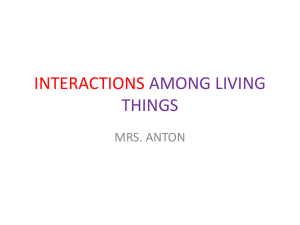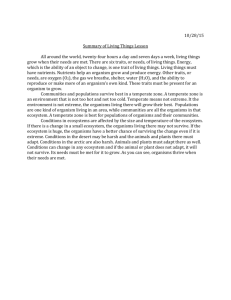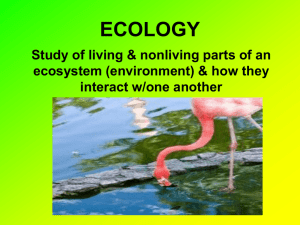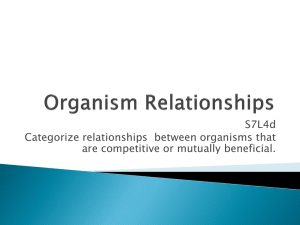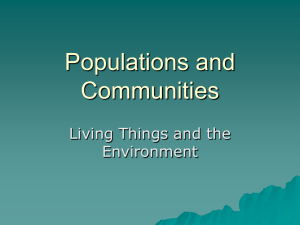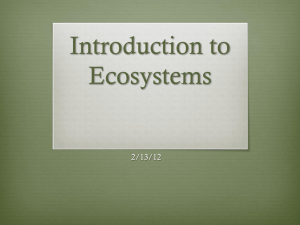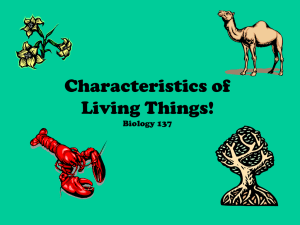Chapter 3 Science Notes
advertisement
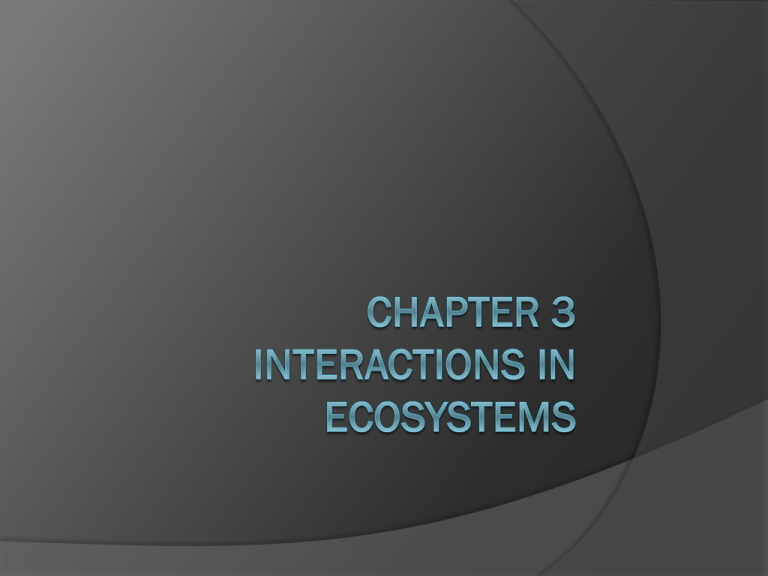
Lesson 1 – Energy Flow in Ecosystems Ecosystem – all living and nonliving things in an environment * Biotic – living things (i.e. plant, animals) * Abiotic – nonliving things (i.e. water, soil) Lesson 1 Continued… Population – includes all the members of a single species Food chain – the path that energy and nutrients follow in an ecosystem * The energy in a food chain starts with the sun. It is the energy source for almost all organisms on earth. Lesson 1 Continued… How are food chains alike? Energy flows in one direction in food chains. Producers are at the bottom of every food chain. General pattern of a food chain! Producer Herbivore Carnivore Decomposer Lesson 1 continued… Consumers – any animal that eats plants or other animals * herbivores – animals that eat plants (squirrels, some birds, some insects) * carnivores – animals that eat other animals (bobcats, hawks) * omnivores – animals that eat both plants and animals (raccoons, woodpeckers, mice, and some crabs) * decomposers – break down dead or decaying plant and animal material (fungi, bacteria, termites, and some worms) Lesson 1 continued… Predator – an animal that hunts other animals for food Prey – organisms that are eaten by other animals Lesson 1 continued… What are food webs made of? Arrows pointing to an organism show the living things that organism eats Arrows pointing away from show the animals that eat that organism Lesson 1 continued…. How do energy pyramids compare? When a producer is eaten, only 10% of the food energy it contains gets turned into herbivore/omnivore tissue. The rest (90%) is lost! It takes a H UGE number of organisms to support an ecosystem. The bottom level (producers) is the largest level because it contains the most organisms and also the most energy. Food Chain Video (15 min) The Food Chain Mystery Lesson 2: Relationships in Ecosystems Why do organisms compete? A limiting factor is any resource that restricts the growth of populations. A carrying capacity is the greatest number of individuals within a population that an ecosystem can support. 1. 2. 3. If a jaguar population increases, food becomes harder for them to find. Soon, the jaguar population decreases, which means their food supply will rise back up. The cycle starts all over again Would you want to survive by drinking this water? (algae is limiting factor) Lesson 2 continued…. How do organisms avoid competition? A habitat is the physical place where an organism lives and hunts for food. A niche is the special role an organism plays in a community -example: 2 birds live in the same location and eat the same food. But 1 bird is active at night while the other is active during the day. Therefore, the 2 birds can have different niches. Swampland habitat Ocean habitat Desert habitat Lesson 2 continued How do organisms benefit from interaction? Symbiosis a relationship between two or more kinds of organisms that lasts over time Types of Symbiotic relationships: * Mutualism – benefits both organisms * Commensalism –one organism benefits without harming the other (examples: Remora fish and rays/sharks; the growth of orchids on trees in the rainforest; barnacles growing on the backs of whales.) Remora Fish riding on the belly of a shark Barnacles Lesson 3: Adaptation and Survival What is adaptation? Adaptation – any characteristic that helps an organism survive in its environment Structural Adaptations are adjustments to internal or external physical structures (examples: fur color, long limbs, strong jaws, the ability to run fast, strong sense of smell, sharp teeth). Behavioral adaptations are adjustments in an organism’s behavior. (3min. 54sec. Video clip about how animals make Structural and Behavioral adaptations) Lesson 3 continued…. What are some animal adaptations? Protective coloration – a type of camouflage where the color of the animal helps it blend in with its background. Mimicry – when an animal is protected against predators by its resemblance to an unpleasant animal. (Example: The king snake mimics the coloring of the poisonous coral snake)




